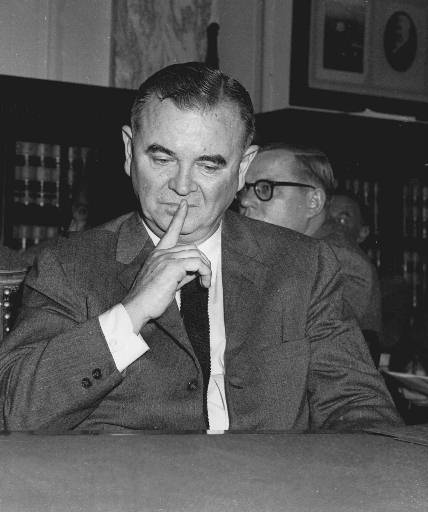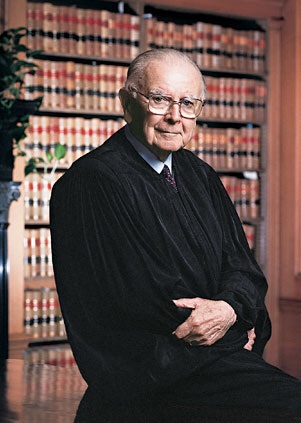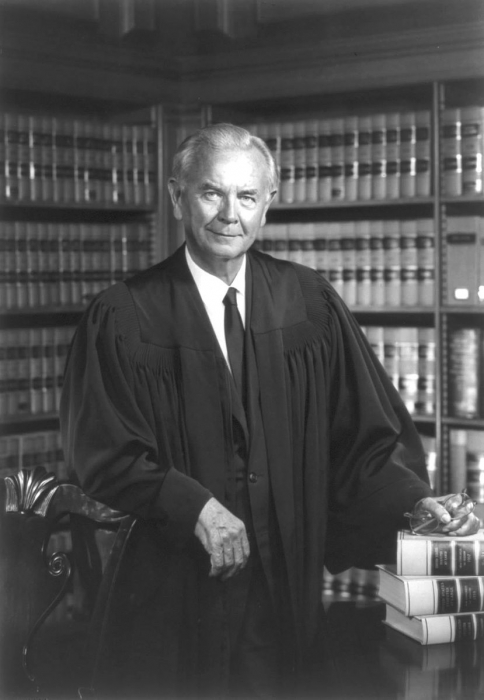William J. Brennan Jr. (1906–1997) served more years as an associate justice of the Supreme Court (1956–1990) than all but seven other justices in the Court’s history. Brennan believed that the law should preserve the dignity of individuals and was concerned with the impact the Court’s decisions would have on people’s lives. As a result, he was an outspoken defender of the First Amendment freedoms of speech and the press against threats of government restriction, and he contributed to significant opinions on free exercise and establishment of religion.
The son of Irish immigrants, Brennan was born in Newark, New Jersey. After graduating from Harvard Law School in 1931, he practiced law in New Jersey. He was a nationally known state appellate judge when President Dwight Eisenhower nominated him for the Court in 1956. Some scholars consider him to have been the Court’s most influential associate justice, reflecting the important role he played in shaping decisions under Chief Justice Warren E. Burger.
Brennan wrote a landmark libel decision
Writing for the majority in New York Times Co. v. Sullivan (1964), Brennan declared that public officials may not sue news media for slander or libel unless the injurious statement is made with actual malice or reckless disregard for the truth. The decision struck down an Alabama law under which the Montgomery city commissioner had sued the New York Times for libel after the paper published an advertisement accusing the city of unleashing “an unprecedented wave of terror” against civil rights demonstrators. The commissioner claimed that the advertisement contained minor factual errors and that, although he had suffered no actual loss, he had been libeled. Alabama courts awarded him an historic $500,000 in damages. Had the Supreme Court upheld the Alabama libel judgment, newspapers would be reluctant to print items critical of public officials for fear that minor factual errors would make them vulnerable to lawsuits.
Brennan noted that the nation’s interest in “uninhibited, robust, and wide-open” debate on public issues might include “vehement, caustic, and sometimes unpleasantly sharp attacks on public officials.” The Constitution requires those officials to endure such criticism unless the statements were made with “actual malice — with knowledge that it was false or with reckless disregard of whether it was false or not.” While Sullivan reduced public officials’ protection from libelous statements, the Court believed that free discussion must include the freedom to criticize those in power.

William J. Brennan, nominated by President Eisenhower to be a Supreme Court justice, sits in a hearing room in 1957, as the Senate Judiciary Committee holds a public hearing on his nomination. Brennan wrote for the majority in the landmark case New York Times Co. v. Sullivan (1964). Brennan declared that public officials may not sue news media for slander or libel unless the injurious statement is made with actual malice or reckless disregard for the truth. (AP Photo, used with permission from the Associated Press)
Brennan attempted to determine what categorized obscene expression
Brennan also participated in decisions that attempted to determine what should be categorized as obscene expression, which is not protected by the First Amendment. The line separating obscene from protected speech is difficult to draw, however. Brennan wrote the majority opinion in Roth v. United States (1957), in which the Court defined obscenity as “material which deals with sex in a manner appealing to the prurient interest.” This test would be met if “to the average person, applying contemporary standards, the dominant theme of the material taken as a whole appeals to prurient interests.” Nine years later, Brennan wrote in Memoirs v. Massachusetts (1966) that obscenity was material “with no redeeming social value.”
By 1973 Brennan had decided that it was impossible to construct a workable definition. He expressed that view in his dissent in Paris Adult Theatre I v. Slaton (1973): “No one definition, no matter how precisely or narrowly drawn, can possibly suffice for all situations, or carve out fully suppressible expression from all media without also creating a substantial risk of encroachment upon the guarantees of the Due Process Clause and the First Amendment.” He noted that governments could prevent children and nonconsenting adults from being exposed to certain materials but could not completely ban the materials.
Brennan also dissented in Hazelwood School District v. Kuhlmeier (1988), when the Court approved a principal’s censorship of a student newspaper. Traditionally the Court had held that freedom of the press prohibited repressing expression before it was printed. Brennan wrote that because students “do not shed their constitutional rights to freedom of speech or expression at the schoolhouse gate,” the Court’s decision taught the wrong civics lesson.

New Associate Supreme Court Justice William J. Brennan holds his 7-year-old daughter Nancy as his wife, Marjorie, holds his robe in 1956, in the Supreme Court building. Brennan participated in decisions that attempted to determine what should be categorized as obscene expression, which is not protected by the First Amendment. The line separating obscene from protected speech is difficult to draw, however. Brennan wrote in Memoirs v. Massachusetts (1966) that obscenity was material “with no redeeming social value.” (AP Photo, used with permission from the Associated Press)
Brennan’s opinion on flag burning was one of his most significant
Among Brennan’s last and most significant opinions on free expression was the majority decision in Texas v. Johnson (1989). Gregory Lee Johnson had burned an American flag in protest at the 1984 Republican National Convention. Although no one was injured or threatened by the demonstration, Johnson was charged under a Texas criminal statute for desecrating a venerated object. The Court determined that Johnson’s act was “expressive conduct” intended to convey a political message. Brennan wrote, “If there is a bedrock principle underlying the First Amendment, it is that the Government may not prohibit the expression of an idea simply because society finds the idea itself offensive or disagreeable.” The protection of the freedom to express unpopular ideas, symbolized by burning the flag, was more important than protecting the “cherished emblem.”
The extremely unpopular Johnson decision led to protests, attempts to amend the Constitution, and the enactment of a federal law prohibiting flag desecration. In another opinion written by Brennan, United States v. Eichman (1990), the Court found the federal statute to be just as unconstitutional as the Texas law.
Brennan supported a wall of separation between church and state
Brennan consistently supported a high wall of separation between church and state. He wrote an important concurrence in Abington School District v. Schempp (1963), finding mandatory Bible reading in public schools unconstitutional. He noted that even if such practices were acceptable at the time the Constitution was written, the educational landscape in the mid-twentieth century was significantly different. For example, education had become the responsibility of the government rather than the private schools the founders knew. In addition, the religious beliefs of the U.S. population had become vastly more diverse. Finally, he believed that public schools could best serve their civic functions if they were free of divisive or parochial concerns.
Brennan’s view differed from that of the majority of his colleagues on the Court in Marsh v. Chambers (1983), in which the Court upheld prayers in legislative chambers. He asserted that such prayers failed the Lemon test, devised by the Court in 1971 to determine whether a policy violated the constitutional ban on the establishment of religion. Under Lemon, to be constitutional a governmental action must have a secular purpose, must neither advance nor inhibit religion, and must not foster “an excessive government entanglement with religion.”
Brennan believed the Court majority ignored the Lemon test in Lynch v. Donnelly (1984), when the Court ruled that Pawtucket, Rhode Island’s display of a life-sized nativity scene in a public park paid for with public funds was constitutional. By contrast, Brennan found that the “inescapable effect of the creche will be to remind the average observer of the religious roots of the celebration he is witnessing and to call to mind the scriptural message that the nativity symbolizes.”

Justice William J. Brennan consistently supported a high wall of separation between church and state. He wrote an important concurrence in Abington School District v. Schempp (1963), finding mandatory Bible reading in public schools unconstitutional. He noted that even if such practices were acceptable at the time the Constitution was written, the educational landscape in the mid-twentieth century was significantly different. (Image via Wikimedia Commons, public domain)
Brennan supported the free exercise clause
Brennan also delivered the Court’s opinion in Sherbert v. Verner (1963), an important free exercise case. Adeil Sherbert, a Seventh-Day Adventist, had been fired and denied unemployment benefits after she refused to work on Saturday, the Sabbath in her religion. Brennan wrote that she was being forced to choose either to follow the teachings of her faith and give up benefits or to abandon her religious beliefs to accept work. Ruling that Sherbert did qualify for state unemployment benefits, Brennan stated, “Governmental imposition of such a choice puts the same kind of burden upon the free exercise of religion as would a fine imposed against appellant for her Saturday worship.”
In another free exercise case, Brennan dissented in Goldman v. Weinberger (1986), arguing that an Air Force officer who was an Orthodox Jew should be allowed to wear a yarmulke with his uniform. Congress later enacted a law that reflected Brennan’s position.
He also dissented in O’Lone v. Estate of Shabazz (1987), which concerned Muslim inmates’ complaints that prison rules prevented them from participating in Friday prayers, their most important weekly religious ritual. Although the majority of the Court deferred to the prison administration’s claim that it would be disruptive to interrupt work to permit Friday prayers, Brennan rejected that position. He likened the situation to preventing Catholic prisoners from attending Sunday Mass. In both cases, inmates would be “foreclosed from participating in the core ceremony that reflects their membership in a religious community.”
This article was originally published in 2009. Mary Welek Atwell is Professor Emerita of Criminal Justice at Radford University. She is the author of five books and numerous articles about legal and justice issues. She holds a PhD from Saint Louis University.

